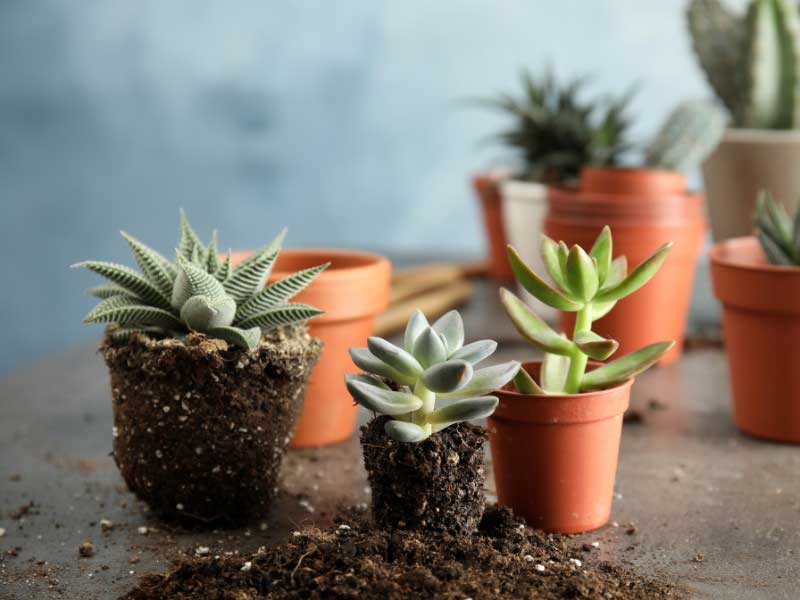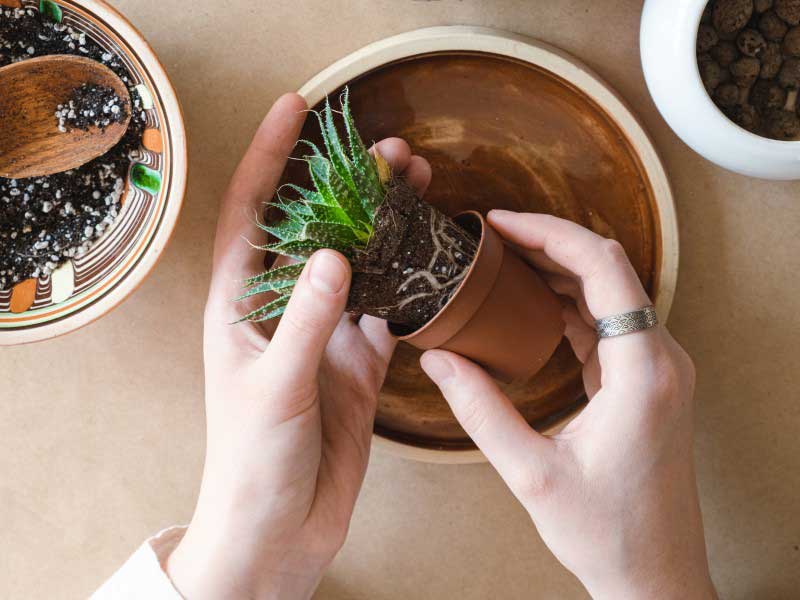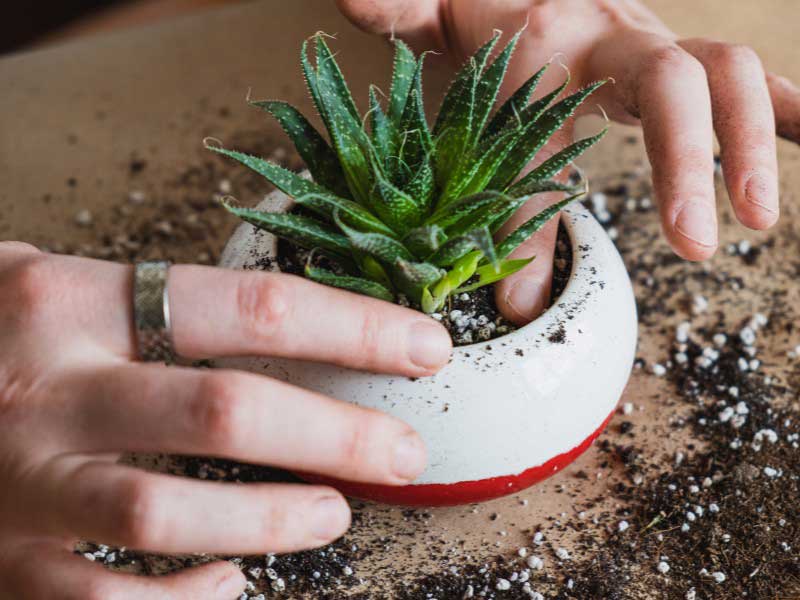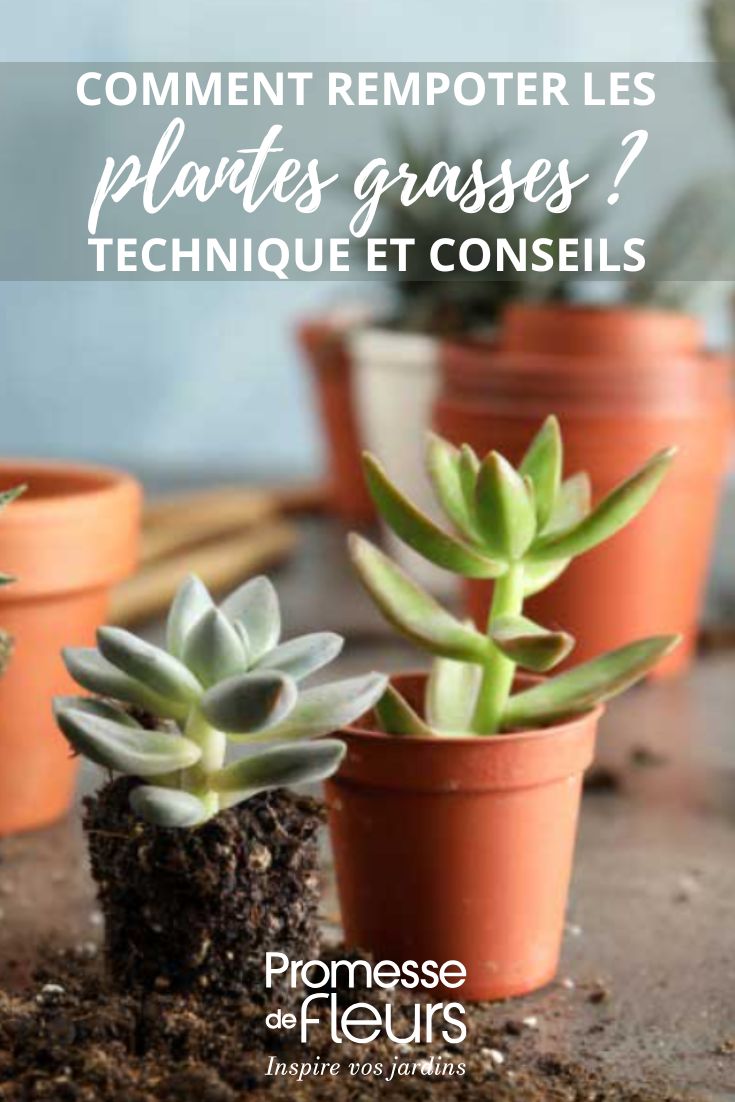Succulent plants are characterised by their fleshy leaves or stems, which are thick and allow them to store water, enabling them to withstand periods of drought. These plants are often very graphic and decorative, and are particularly suited for pot cultivation, whether on a terrace or indoors, depending on the species and their hardiness. They are sensitive to excess moisture and require a draining substrate. Repotting is an essential step to support their growth by renewing the substrate and providing more space for the roots. This operation is accessible to everyone with a bit of organisation and the right tools. Discover all our tips for successfully repotting your succulent plants!
Why repotting your succulent plants?
Even though they grow slowly, it is important to repot succulent plants from time to time, as this allows for their growth by giving more space to the roots and renewing the substrate, which tends to deplete over time. This can also encourage flowering. A pot that is too small could hinder the growth of your succulent plants and suffocate their roots. Some signs may indicate that repotting is necessary: roots coming out of the pot, compacted or ineffective substrate, slowed growth, yellowing leaves, or visible mould.

When to repot succulent plants?
The ideal time is spring, as growth resumes or begins. It is advisable to avoid repotting during flowering or peak growth. However, repotting outside of this period can be considered, provided that the roots are well dried.
What pot to choose to repot your succulent plants?
The ideal pot should be only a little larger than the previous one, as a container that is too large retains moisture and endangers the roots. We recommend choosing a terracotta pot, as they allow for better aeration of the roots, limiting the risks of excess moisture and rot. Plastic and ceramic pots are also suitable, provided that the bottom has a drainage hole, which is essential to prevent stagnation.
With what substrate?
Succulent plants require a light and draining substrate. You can plant them in a mixture of potting soil and coarse sand or perlite, possibly supplemented with gravel. You can also use special cactus and succulent potting soil directly. A drainage layer placed at the bottom of the pot, made of clay balls or gravel, further improves water drainage and effectively protects the roots from rot.
Necessary materials
- A new pot of appropriate size with drainage holes.
- A draining substrate that is well-aerated (mixture of potting soil and sand, or potting soil for succulent plants).
- A drainage layer (gravel, clay balls, shards).
- Gardening gloves, if you are repotting a spiny plant, such as a cactus.
- A clean and disinfected pruning shear to remove dead or damaged roots.

Practical steps to repot your succulent plants
- Place the drainage layer (about 2 cm) at the bottom of the pot, then add a small amount of substrate.
- Gently remove the plant from its pot. Tap the sides of the pot gently to release the root ball. If the plant is difficult to extract, breaking the pot may be preferable to damaging the plant.

- Clean the root ball: remove the old substrate, possibly using a stick or a brush.
- Inspect the roots: cut away any soft, dry, or rotten parts with a disinfected pruning shear.

- Position the root ball in the centre of the pot, on a bed of substrate, at the same depth as before.
- Add substrate around the root ball, lightly compacting without burying the collar (base of the plant).
- Optionally, add a thin layer of gravel or sand on the surface of the potting soil.
- Wait at least 1 to 2 weeks before the first watering to allow damaged roots to heal.
- Avoid direct sunlight for 3 to 4 weeks.

After repotting: care and maintenance
Once repotting is complete, it is advisable to place the plant in a bright location, but out of direct sunlight, especially during the first few weeks. This resting period allows it to adapt to its new substrate without experiencing additional stress.
Watering should be paused for one to two weeks to allow the roots to heal, then resumed gradually and moderately. Excess water must be absolutely avoided, as it poses a much greater risk of rot than temporary drought. It is also unnecessary to mist the foliage or maintain high ambient humidity.
Finally, it is important to protect the plant from cold drafts and monitor its recovery: if the foliage remains firm and colourful after three to four weeks, it indicates that the repotting has been well accepted and that the plant is ready to return to its normal care routine.
































Comments